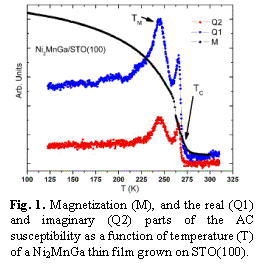
ACS PRF | ACS
All e-Annual Reports

42068-GB5
Seeking the Origin of Martensitic-Like Transformations in Co2MnSi Thin Films
Our studies of magnetic and structural transitions in Heusler alloys have advanced significantly. Our recent progress on Ni2MnGa and Co2MnSb1-xSnx is described below.
I. Ni2MnGa:
The Heusler alloy Ni2MnGa has been of intense interest recently as a parent alloy for a large array of materials that exhibit many useful physical properties. Some of the most useful properties include shape-memory effects, giant magnetocaloric effects, giant magnetoresistance, and exchange bias. It is important to be able to fabricate these systems in thin film form for a number of reasons. For instance, many applications require thin film components (e.g., magnetoresistive sensors), the physical properties can be altered or enhanced in thin films (reduced dimensionality), and thin films are easier to study using certain techniques (e.g., x-ray magnetic circular dichroism).
 Ni2MnGa have been grown on various substrates using pulsed laser deposition. These films have been characterized structurally using x-ray diffraction and magnetically using a SQUID magnetometer and an optical magnetic susceptibility system. The magnetization and susceptibility data are shown in Fig. 1, and both clearly exhibit the magnetic transition (or Curie temperature, TC) at TC»275K. The Curie temperature in bulk Ni2MnGa appears at about 376 K. Two things can account for the difference between bulk and film transition temperatures: (i) Altered stoichiometry from that of the bulk system in the films, and (ii) Curie temperatures in thin films are typically lower than corresponding bulk values.
Ni2MnGa have been grown on various substrates using pulsed laser deposition. These films have been characterized structurally using x-ray diffraction and magnetically using a SQUID magnetometer and an optical magnetic susceptibility system. The magnetization and susceptibility data are shown in Fig. 1, and both clearly exhibit the magnetic transition (or Curie temperature, TC) at TC»275K. The Curie temperature in bulk Ni2MnGa appears at about 376 K. Two things can account for the difference between bulk and film transition temperatures: (i) Altered stoichiometry from that of the bulk system in the films, and (ii) Curie temperatures in thin films are typically lower than corresponding bulk values.
Both the real (Q1) and imaginary (Q2) parts of the magnetic susceptibility show a feature at about TM=240K. This has been identified as the martensitic transition (TM), which is a well known magnetostructural transformation (i.e., a compound magnetic and structural transition). In this type of transformation the crystalline lattice is coupled to the external field, and it is this phenomenon that is responsible for the occurrence of large magnetocaloric effects and shape memory properties in these systems. Measurements are still being carried out in order to determine the effects of stoichiometry and deposition conditions on the various magnetic and structural transitions. One objective is to study the temperature dependent x-ray magnetic circular dichroism in these samples as a function of temperature near the various transitions.
II. Co2MnSb1-xSnx

Theoretical predictions indicate that this Heusler alloy, with the proper choice of concentration x, is a possible half-metallic (i.e., fully spin-polarized) material. A series of Co2MnSb1-xSnx alloys (x = 0, 0.25, 0.50, 0.75, and 1) have been fabricated using conventional arc-melting techniques for use as targets for the deposition of thin films. A series of films have been grown on a variety of substrates: SrTiO3, GaAs, Si, and glass. We have identified the growth parameters that yield very high quality epitaxial films on GaAs (001).
 The magneto-optic Kerr effect (MOKE) hysteresis loops of a 250 Ε Co2MnSb film grown on GaAs (001) is shown in Fig. 2. X-ray diffraction measurements indicated that the film had a (100) preferred orientation, and the MOKE measurements demonstrate that the film is nearly single crystalline. The MOKE data identify the easy axis as that which points along the [011] direction of the substrate, and the easy axis points along [001]. In addition, the [01-1] and [010] axes are identified with the hard-easy and the easy-hard axes, respectively.
The magneto-optic Kerr effect (MOKE) hysteresis loops of a 250 Ε Co2MnSb film grown on GaAs (001) is shown in Fig. 2. X-ray diffraction measurements indicated that the film had a (100) preferred orientation, and the MOKE measurements demonstrate that the film is nearly single crystalline. The MOKE data identify the easy axis as that which points along the [011] direction of the substrate, and the easy axis points along [001]. In addition, the [01-1] and [010] axes are identified with the hard-easy and the easy-hard axes, respectively.
The anisotropy of these films has been studied using rotational MOKE methods and ferromagnetic resonance (FMR). The results indicate that the anisotropy (i.e., the dependence of the magnetization on crystallographic direction) has a cubic (four-fold) component due to the film symmetry, and a uniaxial component due to the substrate GaAs. In addition, the degree of anisotropy depends on composition and, in some cases, the dominant component depends on film thickness. In some instances the easy axis rotates by 90 degrees. Four-fold symmetry can be seen in a Co2MnSb film by measuring the squareness (S) of the hysteresis loop as a function of angle (Fig. 3(A)). The ROTOMOKE method (where the Kerr intensity is measured as a function of in-plane field angle) was also used to understand the magnetocrystalline anisotropy of thin films. Anisotropy can depend on many factors, one of which is composition. The ROTOMOKE data for three full-Heusler alloy films are shown in Fig. 3, along with the Fourier fits. Films that possess little anisotropy should closely follow a cosine dependence. As seen in Fig. 3(B), Co2MnSn (red curve) follows a nearly cosine dependence, and the others deviate from cosine, with Co2MnSb showing the largest deviation. These deviations are evident in the Fourier analysis (coefficients given in Fig 3(C)), and can be attributed to various physical characteristics such as magnetocrystalline anisotropy, stress/strain, shape anisotropy, and surface roughness.